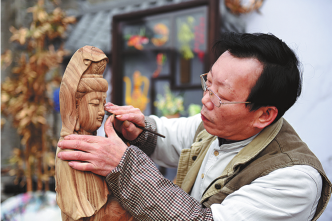MASTER CRAFTSMAN TO RESTORE LONG-STANDING TRADITIONS
 |
|
Jin Zisong, an inheritor of Chaozhou woodcarving |
At a woodcarving studio founded by Jin Zisong in Chaozhou, Guangdong province, several craftsmen were busy working.
Having just returned from an exhibition organized by a crafts and arts association in Guangdong province, Jin said his team was to participate in another focused on culture and tourism in order to showcase the charm of Chaozhou woodcarving.
The tight schedule doesn't bother Jin, as he is passionate about Chaozhou woodcarving art. Among the time-honored schools of traditional Chinese woodcarving crafts, Chaozhou woodcarving features unique characteristics. It uses a technique of hollowing out the background to make the decoration stand out.
As a representative inheritor of the national intangible cultural heritage, he has earned himself a good reputation over his nearly five decades of craftwork.
Jin, a Chaozhou native, has been fond of fine arts and folk art since childhood.
In 1973, he was admitted to an arts and crafts training program in Chaozhou and worked as an apprentice in a local woodcarving workshop.
In 1984, Jin founded his own studio, which was assessed by the then Guangdong provincial department of culture as a provincial intangible cultural heritage inheritance base and a provincial production demonstration and protection base.
With nearly 50 years of practice in the sector, Jin is a master of woodcarving, proficient in all kinds of carving techniques. At present, not only in Chaozhou but in cities like Guangzhou, capital of Guangdong province, Jin has created many woodcarvings.
Today, when visitors step into the Guangzhou Cantonese Opera Art Museum, they will be met by a masterpiece created by Jin.
Entitled Baxian Heshou, or Birthday Celebration by Eight Immortals, the woodcarving work, coated with gold foil, features a double-sided carving. Jin was invited to create it for the museum when it was about to open back in 2015.
"It (the woodcarving work) was a first attempt to integrate Chaozhou woodcarving with Cantonese opera. You can imagine how difficult it could be," Jin recalled.
On the 8-centimeter-thick camphorwood, Jin used innovative carving techniques to allow the finished work to be appreciated from both sides. It took Jin and his two associates nearly 18 months to complete.
The innovation of the double-sided hollowed-out woodcarving is one more facet for appreciation and thus has given the traditional craft greater development room, Jin said.
Later, based on the Birthday Celebration by Eight Immortals, he and one of his associates spent one year creating Qunxian Heshou, without gold foil, for display in his studio. The new creation represents a scene where more immortals congratulate a top goddess in ancient myths, called Wangmuniangniang, on her birthday.
Jin said he personally prefers plain woodcarvings without the coating of gold foil, though that means more attention needs to be paid to crafting skills and the choice of wood materials, as there is little room left for repairs to any errors.
"The plain woodcarvings are a test of crafting skills and have a greater texture," he said, adding they also have better market prospects.
Another of Jin's signature creations was inspired by A Dream of Red Mansions, one of the four ancient Chinese literature classics. Combining the literature with his craftsmanship, the carved ornament portrays nearly 20 scenes and features more than 60 figures. It is considered a masterpiece showcasing traditional Chinese culture. The first one was bought by a renowned Malaysian entrepreneur in 2013.
"We are so far the only ones that are able to use the hollowed-out crafting technique to create figures in Chaozhou woodcarving," he said proudly.
Throughout his art career, Jin has been thinking about how to better carry forward the cultural treasure of Chaozhou woodcarving.
With the development of modern science and technology, mechanical production of woodcarving can imitate 80 percent of handmade work. It has affected the manual woodcarving industry and replaced it to a large extent, Jin said.
However, the most delicate parts of manual woodcarving have not yet been replaced by machinery, Jin noted.
Mechanical woodcarvings generally look stiff and rigid, while manual ones are made with a craftsmen's thoughts and feelings, which inject life into their creations, he said. A craftsman's inner world can be read via his woodcarving creations, which are interlinked with other arts like painting and calligraphy, according to Jin.
To attract more young people to learn Chaozhou woodcarving, Jin gives lectures in universities. He also participates in exhibitions to expand the influence of the folk art.
To his delight, a growing number of young people are interested in woodcarving, and Jin has recruited apprentices at his woodcarving studio.
Each apprentice has to study for four to six years before they can complete a single piece of woodcarving on their own, Jin said.
"I have often told them to strive for perfection as a craftsman, for a good work is like a graceful lady, who will have admirers," Jin added.
Connecting woodcarving products with the market is another approach proposed by Jin, which is expected to help promote the inheritance and development of the traditional art.
Each woodcarving work is a creative cultural product. It can strike a balance between artistry and practical utility, as it can be used in decorating buildings and furniture, Jin said.
If woodcarving products can expand in sales, it will help to boost the development of the woodcarving craft, Jin added.
Chaozhou woodcarving
Chaozhou woodcarving is a folk carving art in Guangdong province, mainly used to decorate buildings, furniture and sacrificial utensils. It began in the Tang Dynasty (618-907), matured in the Ming Dynasty (1368-1644) and reached its peak in the Qing Dynasty (1644-1911). Chaozhou woodcarving products mostly take history, mythology, stories, auspicious animals and flowers as themes. They are mostly made of camphor wood. There are various forms of carving, such as relief, circular carving and hollow engraving, which allows the finished products to be exquisite and rich in layers. With lacquer coating and gold leaf, the wood-carved products look resplendent, magnificent and elegant. In 2006, Chaozhou woodcarving was included on the first national intangible cultural heritage list.





















